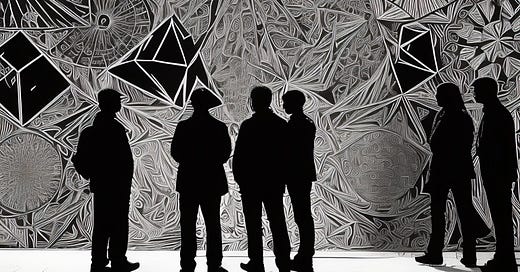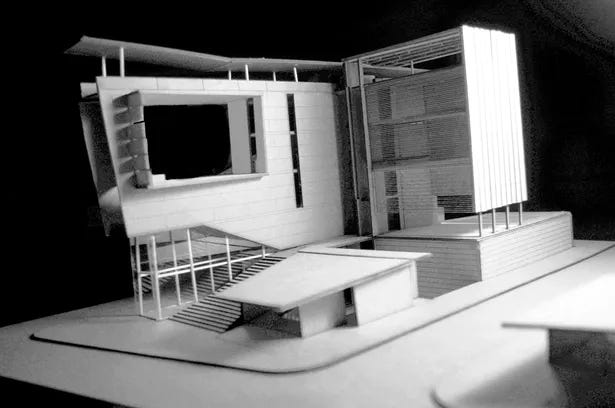Studio Culture
Architecture school was a 5-year military-grade boot camp for designers. Why does studio culture motivate students so intensely? We’ll look into the power of autonomy, feedback, and friendship.
What makes design studio so intoxicating?
Architecture school & the fusion of creative work with community
I raced the sun on my drive back to family dinner. Golden light poured out of my speakers and disappeared into the interstate wind. Screaming along to “Oh! Darling” kept me awake until I could crash into my parents driveway. I remembered the talk from the AIAS conference last summer. They taught us how driving with your eyes closed is more dangerous than drunk driving. There were too many stories of students falling asleep at the wheel after an all-nighter. I made it home, and stumbled up the stairs into a big hello. "You're back!” I’ve been at school for days straight. I couldn’t remember the last time I was home.
Design studio was both a rush and a blur. To people on the outside looking in, it was a strange phenomenon. You could walk by Education Hall on any given night and glimpse the midnight lamps flickering. It seemed like a weird way to experience college. Was it a cult? Were they sacrificing freshman to Le Corbusier? There must have been some kind of hazing involved.
“When was the last time you slept?” was a frequent question from friends and classmates alike. It was a competition to many. After I hallucinated jungle sounds during my Design II crit, I learned the value of a solid nap. I had an air mattress, and some had hammocks under their drafting desk. Even though the studio was only a 20 minute drive from home, I embraced a lifestyle of sleeping fast in between design sprints.
The normalcy of all-nighter culture is a problem, but it says something fascinating about design studio. Schools often struggle with keeping their students engaged. Design studio is the opposite. Aspiring architects push their bodies to the limit in the pursuit of creation. "Work smart, not hard," was a mantra repeated by professors. They needed to cut back engagement! What makes people so obsessed with the creative process when they do it in the context of a community?
The traditional education system suggests that people are either inherently motivated or lazy. But architectural school showed me that the learning environment itself can cultivate intense curiosity, creativity, and collaboration. I didn’t feel like I was at school. Design didn’t feel like homework. I was defining my own creative problems, surrounded by my closest friends, and soon I’ll be marrying a girl who went through the whole experience with me.
Here’s a deep dive into this question: Why does “studio culture" motivate students more than the traditional education system?
1.
Open-ended creative problems paired with community pressure pushes students to put out their best work.
Design studio is different from the other classes in architecture school. There aren't lectures, readings, assignments, or tests. You design a single building over a 4-month stretch. It's open-ended, but shared constraints keep everyone in the same boat.
If Danielle was designing a rattle-snake museum in New Mexico, and George was designing a city made for self-driving cars, they wouldn't have a lot to talk about.
"This semester we're designing a dance school on Broadway & Houston St. that needs to include a theatre, studios, and office spaces."
That’s autonomy with constraints. A design problem can be interpreted in an infinite amount of ways. Since everyone shares basic constraints, the students benefit by seeing how others wrestle with the same problem. This also makes it competitive.
2.
There are lessons to be learned by engaging with someone else’s work as if it were your own.
In school, students hand in assignments that get scored privately. A grade is a representation of someone’s ability to solve a narrow set of tasks. In studio, students present something that get evaluated publicly. Considering the visual nature of architecture, someone can gauge the caliber of your work within seconds.
I had one professor who would ask students to leave their study models on a center table when they arrived to class. When the teacher showed up he would arrange the models in a line ranked from most to least interesting. Judgement day! He wouldn't know who made which model. Students wouldn't even get to explain their intent during the ranking process. There was this shared belief that the work should speak for itself.
"Do you think Rem Koolhas stands outside of the Seattle Public Library and hands out pamphlets on why he made design decisions?!"
There was something vulnerable about having your work publicly critiqued. A model was more than a slapped together sculpture of cardboard and glue. It was an encapsulation of your ideas, skills, knowledge, and thought process. But consistent critiques taught everyone not to take feedback personally. It became a ritual to huddle around a table for hours with a professor to engage with each other’s work.
3.
A series of psychological & interpersonal skills compound over time when you solve creative problems in the context of a community.
School is about memorizing facts. When the situation that calls for memorization disappears, the facts disappear with it. Studio allows for slow and steady skill building. You're working and thinking in a certain way for 5 years. As you work through a design, either individually or with a group, your mental muscles get a workout. You're better equipped to handle a similar problem that might arise in the next few days.
Whether you're writing an essay, crafting a song, or designing a building, there are similar skills that you develops:
Envisioning how others might understand your work
Communicating complex ideas through simple "hooks"
Inviting others to comment on your work in a helpful way
Reading body language to interpret how others comprehend
Learning how to gather and prioritize feedback
Challenging your own assumptions
Evaluating and selecting a range of possible tools
4.
The hard-work required to improve is easier to endure when you're doing it with friends.
When you bring together people who are looking to solve similar creative problems, something called “studio culture” emerges. On any given night, you could find Education Hall filled with people. They were chatting over coffee, teaching each other software, jousting with T-squares, fixing plotters, getting high in the parking lot, breaking into the library, reading Aldous Huxley past midnight, watching cartoons, climbing the roof, making out in the stairwell, debating ideas on the Bauhaus, and giving each other design feedback. It was magic.
I met my wife in architecture school. I was a transfer student and she showed me how to fix the plotter. After that we soon become rivals. She was the president of our AIAS chapter (the American Institute of Architecture Students). I organized a grassroots rebellion to secede from National. I posted unstamped flyers around the building encouraging students to revolt against the unjust fees of $50 a year. My architecture club was only $20 a year! My wife reported me. Revolution squashed.
The next year we had Thesis studio together. After everyone left for the night, it was often just her and I left. She had the key to a private student government office. I had an air mattress in my trunk. We were both sleep-deprived, so we put our differences aside and took turns enjoying our make-shift nap station. Eventually, we started hanging out. We went to Abeeza Pizza, we photoshopped pictures of our professors onto geese, we roamed the nearby golf course, we killed “stink bugs,” and we snuck into a Richard Meier building. We started working on each other’s projects as if they were our own, and we started dating the week after graduation.
Most students set up their drafting desks at school. If they worked at home, they’d be missing out on studio culture. At a basic level, everyone was there to work on their projects. But when working together for long enough, the lines between work and play get blurred. Friendships are a critical part of building a community for feedback. Providing feedback wasn't a chore. It was no big deal to sit down with someone for an hour. A conversation could wind between project advice, jokes, philosophy, and non-sense.
Studio is like a boot-camp for designers. It's characterized by its intensity, but you're not doing it alone.
Fellowship of Momentum
Creative work without community is isolating.
Community without creative work is motionless.
The fusion of the two creates a synergy, which I think of as a “fellowship of momentum.” Everyone works together to push each other forward. It's exciting to see how non-architectural programs like NuVu are inspired by design studio. It’s even more exciting to see a program like Write of Passage gain traction, which is a persistent, global, "studio-culture" that lives on the internet.
There are things to learn from architecture school beyond building design.






Fascinating article! Feels like the acorn that will grow into a vast oak tree of Weltanshauung.
I was reminded of this PBS documentary about the culture of nationally dominant creative excellence at Bethlehem Pennsylvania's Liberty High School Band, the Grenadiers. A series of charismatic band directors, including Ron Sherry who is now 91, created the kind of immersive, inspiring "studio culture" you describe, and changed the lives of thousands of high school students who have been band members:
https://www.pbs.org/video/second-to-none-liberty-high-school-grenadier-band-bdzl5y/